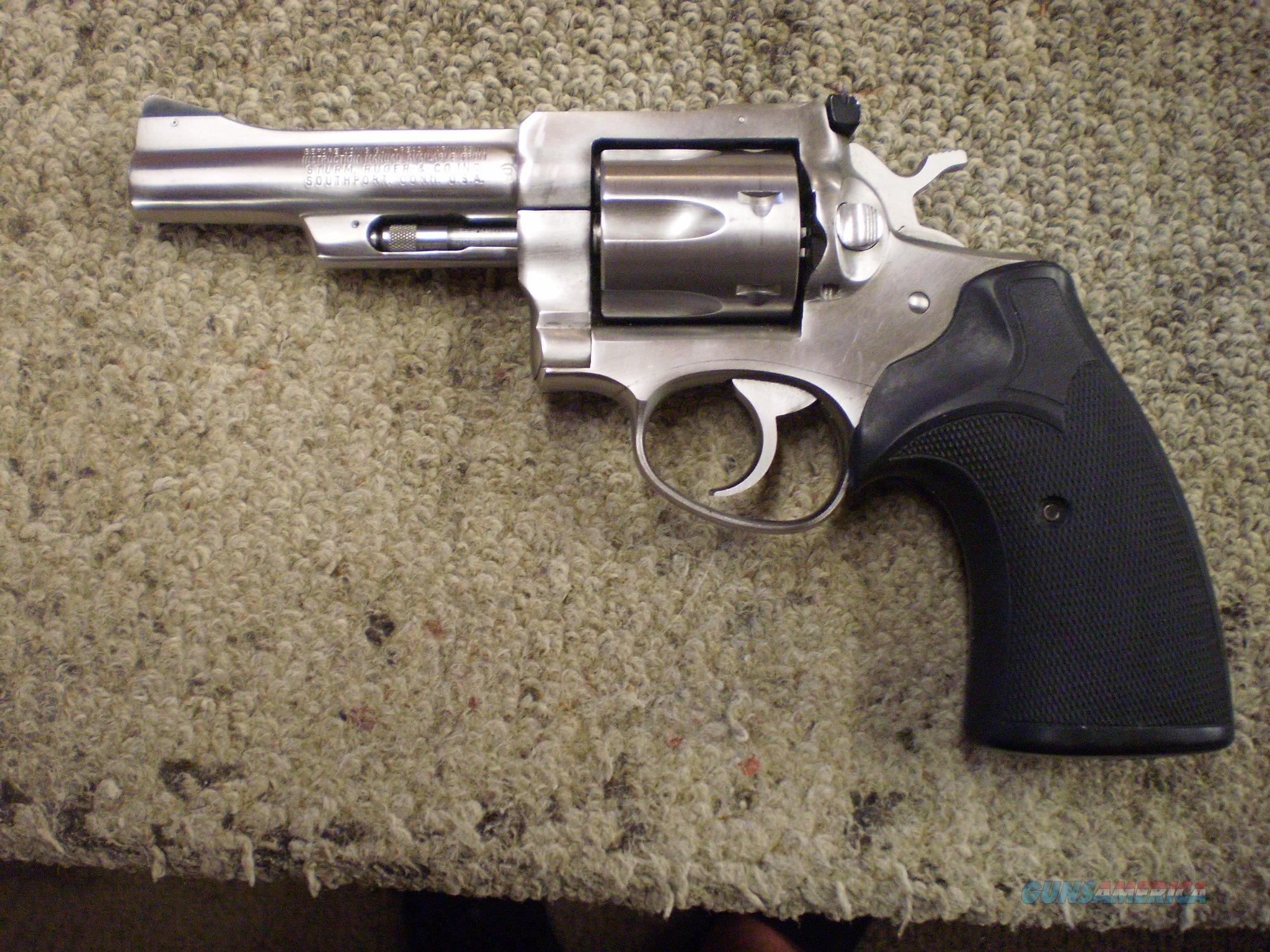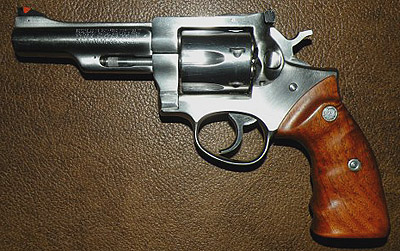| Ruger Security-Six | |
|---|---|
| Type | Revolver |
| Place of origin | United States |
| Production history | |
| Manufacturer | Sturm, Ruger |
| Produced | 1972—1988 |
| No. built | 1,240,000[1]~1,500,000[2] |
| Variants | |
| Specifications | |
| Mass | 33.5 oz (4 inch barrel) |
| Barrel length |
|
| Cartridge |
|
| Action | Double action |
| Feed system | Six round cylinder |
| Sights | Fixed and adjustable iron open |
The Ruger Security-Six and its variants, the Service-Six and Speed-Six are a product line of double-actionrevolvers introduced in 1972 and manufactured until 1988 by Sturm, Ruger & Company. These revolvers were marketed to law enforcement duty issue, military, and civilian self-defense markets.[3]
Ruger Security Six Sights

Development and history[edit]

As far back as 1966, Ruger designers Harry Sefried and Henry Into began working on the company's first double-action revolver. Despite being popular with civilians, Bill Ruger wanted to get into law enforcement and security contracts. Smith & Wesson and Colt at the time dominated the medium frame law enforcement double action revolver contracts.[4] The introduction of the Security-Six and its variants marked Sturm Ruger's first attempt to enter the double-action revolver market. The corporation's earlier designs had been Colt Peacemaker-style single-action revolvers. Ruger used investment casting for most parts in an effort to hold down production costs.[5] As with all Ruger firearms, the Security-Six revolvers were robustly designed with large, heavy-duty parts for durability and to allow for investment casting.[5][6]
Ruger Security Six Blue Parts. Parts and Accessories for the Blue Steel Ruger Model Security Six.38/.357 cal. Items per page: Sort By Page: 1; 31 Item(s) Ruger Security Six Stock Pin. Ruger Security Six Hammer Assembly. The 22-caliber Ruger Single-Six and Ruger Single-Nine, as well as the Ruger Vaquero, which is available in 45 LC, 357 Mag, and 44 Rem Mag, are also well-loved revolvers with an Old West feel.
Sefried had previously worked for High Standard Manufacturing Company, where he designed the High Standard Sentinel revolver. The grip profile of the Sentinel was used on the 'Six' line. Ruger's new double action revolvers were unlike other guns on the market in that they used a one-piece frame, rather than a removable sideplate, which lent them superior strength. The Ruger Redhawk, introduced in 1980 and also designed by Sefried, was a scaled-up and improved version of the Security-Six. The 'six series' line enjoyed sales success because of their basic features, solid construction, and competitive pricing.[5]
Various models were issued by US government agencies as diverse as the former Immigration and Naturalization Service, the Postal Service, the Border Patrol, and numerous police agencies. The Security-Six and its derivatives also became the standard issue service weapons of a large number of police departments, in addition many were exported overseas.[3] While Ruger's Security-Six line has been out of production since 1988, a total of over 1.5 million revolvers were produced and they remain well-liked and respected, as well as highly sought after in the second-hand market.[3][6]
By the early 1980s, it was determined that the Ruger Six line guns were wearing out faster than expected from users that practiced frequently with .357 Magnum ammunition. Ruger commissioned a heavier duty upgrade of the Six line that could handle a 'lifetime diet' of full-powered magnum loads. Ruger's answer to this problem was the GP100, which featured a beefier frame and barrel, stronger steels, a redesigned grip frame and, most notably, a triple-locking cylinder to give extra strength to the action. The GP100 quickly replaced the Security-Six in the Ruger product line, but the Six line is still popular with shooters and collectors today.
Features[edit]
The Security-Six and its variants were more or less identical in basic design, with minor differences in sights (fixed or adjustable) and frame (round or square butt). Although medium-framed in size, the Security-Six was somewhat stronger than competing guns like the Smith & Wesson Model 19 as the Ruger featured a thicker frame without a sideplate cutout, a stronger barrel shank support that prevented catastrophic barrel failure in the six inch model revolvers, larger, stronger internal parts, and an increased diameter cylinder with offset bolt locking notches. The new revolvers were initially manufactured in a bluedcarbon steel finish; in 1975 stainless steel versions of all models were added to the lineup.[3] Featuring six-roundcylinders, the Security-Six series represented one of the first modern revolver designs to feature a hammer powered by a coil spring utilizing a transfer-bar firing system, and was chambered for a variety of centerfire ammunition cartridges including .38 Special and .357 Magnum, as well as .38 S&W and 9×19mm Parabellum (9mm Luger).[3][6] All Security-Six series revolvers came with original equipment manufacturer (OEM) supplied service-style woodengrips.[3] The wood grips were all manufactured for Ruger by W.F. Lett Manufacturing in New Hampshire, a now-defunct contractor. Most of these wood grips featured a diamond-shaped panel of pressed checkering, though smooth walnut grips with uncheckered panels were shipped with some commemorative models. Oversized walnut target/combat grips were also available as a factory option. During the 1980s, some of the Speed- and Service-Six models were also shipped with rubber Pachmayr grips containing the silver Ruger emblem.
- Police service six: an early double action from Ruger. Today we are looking at an early double action from Sturm, Ruger & Co: the Police Service Six. The Police Service Six is a line extension of the Security Six model marketed towards law enforcement in the ’70s and ’80s.
- As with all Ruger firearms, the mainspring on the Security-Six is a coil spring, instead of the then-common leaf spring. Coil springs are used throughout virtually all of Ruger’s guns, save the follower in its bolt-action magazine rifles. Coil springs are less expensive to make in quantity and more consistent in their quality than leaf springs.
Another feature of the Security-Six was straightforward disassembly, which required no tools with the exception of a flathead screwdriver, coin, or cartridge case rim used to remove the grip screw.

Disassembly of the Security-Six is as follows:1: Make sure the firearm is unloaded.2: Turn out grip screw.3: Remove Grips.4: Compress main spring.5: Insert pin and decompress main spring.6: Remove main spring.7: Remove hammer pin.8: Remove hammer.9: Release and remove trigger assembly.10: Release and remove Cylinder.
Security-Six[edit]
Introduced in 1972, the Security-Six was the original model of the new series.[7] The majority of these guns were manufactured with adjustable sights, though a few early models were sold with fixed sights. Security-Sixes could be ordered with either service or 'target' (combat) -style square butt grips. Nearly all Security-Sixes were chambered for the .357 Magnum cartridge, which also permitted the use of the shorter .38 Special cartridge. Ruger also chambered the Security-Six in .38 Special for some police orders by fitting different cylinders that could only accommodate the .38 Special cartridge. Barrel lengths available on the Security-Six included 2.75, 4, and 6 inches.[3][6]
The .357 Magnum, four inch barreled model was standard issue to uniformed officers of the former U.S. Immigration and Naturalization Service[8] as well as Patrol Agents of the U.S. Border Patrol until both agencies adopted .40 caliber semi-automatic pistols.[9]
Service-Six[edit]
After a few months of production, Ruger renamed the fixed-sight version of the Security-Six the Service-Six or alternatively, the 'Police Service-Six'. This was largely a marketing decision and an attempt to capitalize on the lucrative law enforcement service revolver market. The Service-Six was normally chambered in .357 Magnum, though Ruger also built versions in .38 Special and 9mm Luger (Parabellum) for some police orders.[5] The U.S. Military contracted for the fixed-sight .38 Special variant adding a lanyard ring to the butt and designating it the M108. It was to replace aging Smith & Wesson Model 10 for issuing to air crews and military police.[citation needed] The 9mm variant featured cylinder chambers bored to headspace the cartridge on the case mouth instead of the rim, using a patented spring moon clip to permit extraction of the fired case. These alterations allowed the rimless 9mm cartridge to be used in a revolver design. Barrel length options for the Service-Six included 2.75 and 4 inches.[5] The 9mm was also marketed under the designation M109.
Speed-Six[edit]
Incorporating fixed sights and a round-butt frame, and available in .357 Magnum, .38 Special, .38 S&W (.38-200), and 9mm Luger, the Speed-Six was intended for use by plainclothes detectives and others desiring a more concealable handgun. The standard barrel lengths available for these models were the same as those for the Service-Six, but also included a 3-inch length in certain law-enforcement contract orders, such as for the U.S. Postal Service (Model GS33-PS). The .357 Magnum, three-inch barreled model was standard issue to Special Agents of the former U.S. Immigration and Naturalization Service[8] as well as Patrol Agents of the U.S. Border Patrol working plain clothes assignments until both agencies adopted .40 caliber semi-automatic pistols.[9] The .38 S&W variant (in England known as the .380 British or .38-200) was equipped with a military-style lanyard ring, and was sold to law enforcement organizations in India.[3][6] The .357 Magnum version was standard issue for the Royal Ulster Constabulary, who, unlike most police officers in the United Kingdom, were routinely armed.
Operators[edit]
Ruger Security Six 357 Holster
- United KingdomRoyal Ulster Constabulary Police Officers
- United StatesUnited States Postal Police, Immigration and Naturalization Service Special Agents, United States Border Patrol Patrol Agents
References[edit]
- ^'Serial Number Data'.
- ^'Modern Firearms - Ruger Security Six'.
- ^ abcdefgh'Ruger Security Six, Police Service Six, Speed Six and GS32-N revolvers (USA)'. Modern Firearms & Ammunition. Archived from the original on 2010-07-01. Retrieved 2008-12-14.
- ^https://www.shootingillustrated.com/articles/2017/8/3/classics-ruger-security-six-revolver/
- ^ abcdeTong, David. “Ruger Security-Six .357 Magnum Revolver” Chuck Hawks Web site. Accessed December 14, 2008.
- ^ abcdeCrumpston, Mike. 'Revisiting Ruger's Revolvers' BNET Web site. Accessed December 14, 2008.
- ^[1]
- ^ abFormer I&NS Special Agent
- ^ abFormer Border Patrol Agent